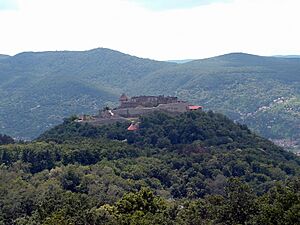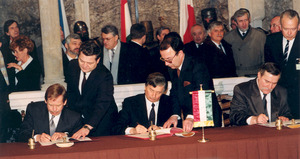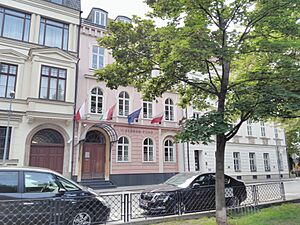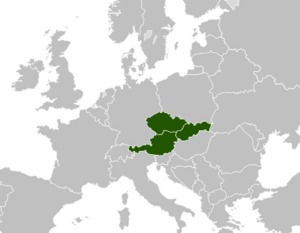Visegrád Group facts for kids
Quick facts for kids
|
|
|---|---|
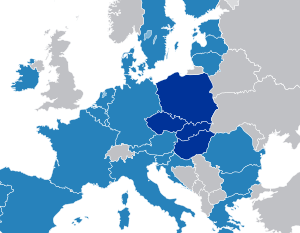
Visegrád Group members Other member states of the European Union
|
|
| Membership | |
| Leaders | |
| Czech Republic | |
| Establishment | 15 February 1991 |
| Area | |
|
• Total
|
533,615 km2 (206,030 sq mi) |
| Population | |
|
• 2024 estimate
|
|
|
• Density
|
117/km2 (303.0/sq mi) |
| GDP (PPP) | 2023 estimate |
|
• Total
|
|
|
• Per capita
|
|
| GDP (nominal) | 2023 estimate |
|
• Total
|
|
|
• Per capita
|
|
The Visegrád Group (also called the Visegrád Four or V4) is a special team of four countries in Central Europe. These countries are the Czech Republic, Hungary, Poland, and Slovakia. They work together on many things like military, money, culture, and energy. All four countries are also part of the European Union (EU) and NATO.
The group started with meetings of leaders from Czechoslovakia, Hungary, and Poland. These meetings happened in the Hungarian town of Visegrád on February 15, 1991. They chose Visegrád because it was where kings from Bohemia, Hungary, and Poland met way back in 1335.
After Czechoslovakia split into two countries in 1993, the Czech Republic and Slovakia both joined the group. This made it four members instead of three. A big goal for the Visegrád Group was for all its members to join the European Union. They achieved this on May 1, 2004.
In 2015, during a time when many people were moving into Europe, the Visegrád Group worked together. They stopped a plan to make countries take in a certain number of people. More recently, the countries had different ideas about the conflict in Ukraine. Even with these differences, the group is still important for helping people and organizations in these countries work together. If the Visegrád Group were one country, it would be similar in size and economy to Metropolitan France.
Contents
History of the Visegrád Group
Early Beginnings (1335–1989)
The Visegrád Group gets its name from a meeting that happened in Visegrád in 1335. The kings of Bohemia (now the Czech Republic), Poland, and Hungary met there. They wanted to create new trade routes to avoid the city of Vienna. This would make it easier to sell their goods in other parts of Europe. They also agreed that Bohemia would control the area of Silesia.
Another meeting happened in Visegrád in 1339. At this meeting, they decided that if the Polish king died without a son, the Hungarian king's son would become the next King of Poland.
Later, from the 1500s until after World War I, much of these countries were part of or influenced by the Habsburg monarchy. After World War II in 1945, these countries became controlled by the Soviet Union. They were called the Polish People's Republic, the Hungarian People's Republic, and the Czechoslovak Socialist Republic.
In 1989, big changes happened. The fall of the Berlin Wall and the end of communism in Central and Eastern Europe allowed these countries to become free. They started to use capitalism and democracy. In December 1991, the Soviet Union also broke apart. This allowed Poland, Hungary, and Czechoslovakia to look more towards Western Europe.
Forming the Group (1990s)
The Visegrád Group officially started on February 15, 1991. This was at a meeting in Visegrád, Hungary. The leaders who met were Václav Havel from Czechoslovakia, Lech Wałęsa from Poland, and József Antall from Hungary.
The group was formed to help these countries move away from communism. They wanted to make changes so they could join important groups like NATO and the European Union.
In 1993, Czechoslovakia split into two separate countries: the Czech Republic and Slovakia. Both new countries became members of the Visegrád Group. This made the group have four members. All four countries joined the European Union on May 1, 2004. This was a very important step for the group.
Recent History (2004–Present)
After all four countries joined the EU in 2004, their main goal was achieved. Since then, the Visegrád Group has focused on cultural cooperation. They also work together on things like building roads and other important structures.
The group became very active during the European Migration Crisis in 2015. The Visegrád countries strongly disagreed with a plan to share refugees across Europe. This made them very visible in the news.
The conflict in Ukraine that started in 2022 caused some disagreements within the group. Hungary and Slovakia had different views on supporting Ukraine compared to the Czech Republic and Poland. The Czech and Polish governments strongly supported Ukraine. This showed that even close allies can have different opinions on big world events.
Despite these differences, experts say the Visegrád Group is still important. It helps government workers and regular citizens from these countries connect and work together. This cooperation is very helpful when they are discussing things in the EU.
Economies of the V4 Countries
All four countries in the Visegrád Group are considered high-income countries. This means they have strong economies and a good quality of life. They have had steady economic growth for a long time.
Economic Changes
One of the main goals of the Visegrád cooperation was to change their economies. They wanted to move from a communist system to a democratic market economy. This was seen as a way to "return to Europe."
The Visegrád countries did well in this change. They overcame economic problems after the 1989 revolutions. When they joined the European Union, they focused on growing their economies through exports. They became manufacturing centers for companies in Western Europe, especially for German car makers.
In 2009, Slovakia started using the euro as its money. It is the only country in the group to do so. The other three countries are expected to adopt the euro in the future.
Economic Strength
If you put all the Visegrád Group's economies together, they would be the 4th largest in the EU. They would be the 5th largest in Europe and the 15th largest in the world. In terms of international trade, the V4 is also very strong. It ranks 4th in the EU and 8th in the world.
The Czech Republic has the strongest economy per person in the group. Slovakia is next, followed by Hungary and Poland.
Nuclear Energy
The V4 countries are in favor of nuclear power. They want to build more nuclear power plants or start using nuclear power (like Poland). They believe nuclear power is good for their countries.
Czech Republic
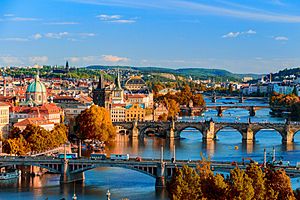
The economy of the Czech Republic is the second largest in the Visegrád Group. It has a high quality of life and a strong economy.
Hungary
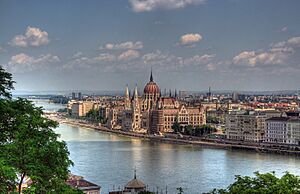
Hungary has the third largest economy in the group. It was one of the more developed countries in the Eastern Bloc. Hungary has attracted a lot of foreign investment since 1989. Its main industries include engineering, chemicals, and food.
Tourism is also very important for Hungary. Lake Balaton is a popular place to visit. The capital city, Budapest, attracts millions of visitors each year.
Poland
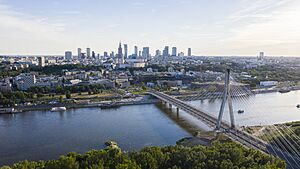
Poland has the largest economy in the Visegrád Group. It is a high-income country with a very good quality of life. The Polish economy is the fifth-largest in the EU. It has been one of the fastest-growing economies in Europe for many years.
Poland was the only EU country that did not have its economy shrink during the late 2000s economic downturn. Its economy kept growing. The biggest part of its economy is the service sector, followed by industry and agriculture. Poland's roads and other important structures have improved a lot with new investments and EU help.
Poland's main industries include mining, machinery (like cars and buses), and chemicals. High-tech and IT companies are also growing there.
Slovakia
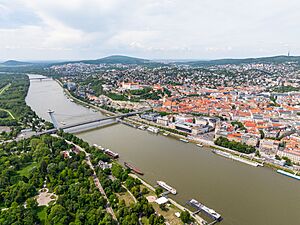
Slovakia has the smallest economy in the V4 group, but it is still quite strong.
People and Cities
The total population of the Visegrád Group is over 64 million people. If it were one country, it would be the 22nd largest in the world. Poland is the most populated country in the group, with about 38 million people. The Czech Republic has about 11 million, Hungary about 10 million, and Slovakia about 5.5 million.
V4 Capitals
- Warsaw (Poland) – 1.79 million people
- Budapest (Hungary) – 1.78 million people
- Prague (Czech Republic) – 1.32 million people
- Bratislava (Slovakia) – 432,801 people
Current Leaders
-
 Czech Republic
Czech Republic
Petr Fiala
Prime Minister -
 Hungary
Hungary
Viktor Orbán
Prime Minister -
 Poland
Poland
Donald Tusk
Prime Minister -
 Slovakia
Slovakia
Robert Fico
Prime Minister
How the Visegrád Group Works Together
International Visegrád Fund
The International Visegrád Fund (IVF) is the main way the Visegrád Group countries work together officially. Its goal is to make connections stronger between people and organizations in Central and Eastern Europe. It does this by supporting projects from non-government groups.
Working Together on Defence
Visegrád Battlegroup
The Visegrád Group countries also work together on defence. In 2011, they decided to create a new EU Battlegroup. This is a military unit that can be ready to act quickly for the European Union. Poland led this group, and it was ready for action in early 2016. The ministers also agreed that their armies should practice together regularly. Another V4 EU Battlegroup was ready in the second half of 2019, and another was ready in the first half of 2023.
Other Defence Areas
In 2014, the countries signed an agreement for a joint military body within the European Union. They work together on things like:
- Planning for defence
- Joint training and military exercises
- Buying military equipment together
- Military education
- Protecting their shared airspace
- Sharing ideas and working together on important issues
A special headquarters for joint logistics support (V4 JLSG HQ) was set up in 2020. It became fully ready to operate by early 2023.
Visegrád Patent Institute
The Visegrád Patent Institute was created in 2015. Its job is to help people and companies get patents for their inventions. It started working on July 1, 2016.
Relations with Neighbors
All members of the V4 have been part of the European Union since 2004. They have also been part of the Schengen Area since 2007. This means people can travel between these countries without passport checks.
European Union Neighbors
Austria
Austria is a neighbor to the southwest of the Visegrád Group. The Czech Republic, Slovakia, and Austria started their own group called the Slavkov format in 2015. This group is an addition to the Visegrád Group, not a replacement.
Germany
Germany is to the west of the Visegrád Group. It is a very important economic partner for all four countries. Germany trades and invests more with the V4 countries than it does with China.
Romania
In 2015, Bulgaria, Romania, and Serbia created their own group called the Craiova Group. This idea came from the Romanian Prime Minister, who was inspired by the Visegrád Group. Greece joined this group in 2017.
Non-EU Neighbors
Hungary, Poland, and Slovakia share a border with Ukraine to their east. Poland also borders Belarus and a part of Russia called Kaliningrad. The Czech Republic is surrounded by other EU countries. Hungary also borders Serbia, which is working to join the EU.
Ukraine
Ukraine is an eastern neighbor of the V4 that is not in the EU. It receives a lot of help from the International Visegrád Fund. The Visegrád Group also helps Ukraine with its goal to become more connected with Europe. Ukraine started a free trade agreement with the EU and the V4 in 2016.
The conflict in Ukraine that started in 2022 caused some disagreements within the Visegrád Group. Hungary had different ideas about how to deal with Russia compared to the Czech Republic, Slovakia, and Poland.
Country Comparison
| Name | Czech Republic | Hungary | Poland | Slovakia |
|---|---|---|---|---|
| Official name | Republic of Poland | Slovak Republic | ||
| Coat of arms |  |
 |
 |
 |
| Flag | ||||
| Population | 10.6 million (2019) | 9.7 million (2019) | 37.9 million (2019) | 5.4 million (2019) |
| Area | 78,866 km² | 93,028 km² | 312,696 km² | 49,035 km² |
| Capital | Prague – 1.3 million (2.6 million Metro) | Budapest – 1.7 million (3.3 million Metro) | Warsaw – 1.7 million (3.1 million Metro) | Bratislava – 429,564 (659,578 Metro) |
| Largest City | ||||
| Official language | Czech | Hungarian | Polish | Slovak |
| Current Head of Government | Petr Fiala (Prime Minister) | Viktor Orbán (Prime Minister) | Donald Tusk (Prime Minister) | Robert Fico (Prime Minister) |
| Current Head of State | Petr Pavel (President) | Tamás Sulyok (President) | Andrzej Duda (President) | Peter Pellegrini (President) |
| Main religions | Mostly undeclared or no religion, some Roman Catholic | Mostly Catholicism and Protestantism | Mostly Roman Catholic | Mostly Roman Catholic |
| Main ethnic groups | Czechs, Slovaks, Ukrainians | Hungarians, Roma, Germans | Poles | Slovaks, Hungarians, Roma |
| Currency | Czech koruna (CZK) | Hungarian forint (HUF) | Polish złoty (PLN) | Euro (€) |
Other Groups in Central Europe
- Three Seas Initiative
Similar Groups
- Craiova Group
- Lublin Triangle
- Nordic-Baltic Eight
- Weimar Triangle
More to Know
See also
 In Spanish: Grupo de Visegrado para niños
In Spanish: Grupo de Visegrado para niños



